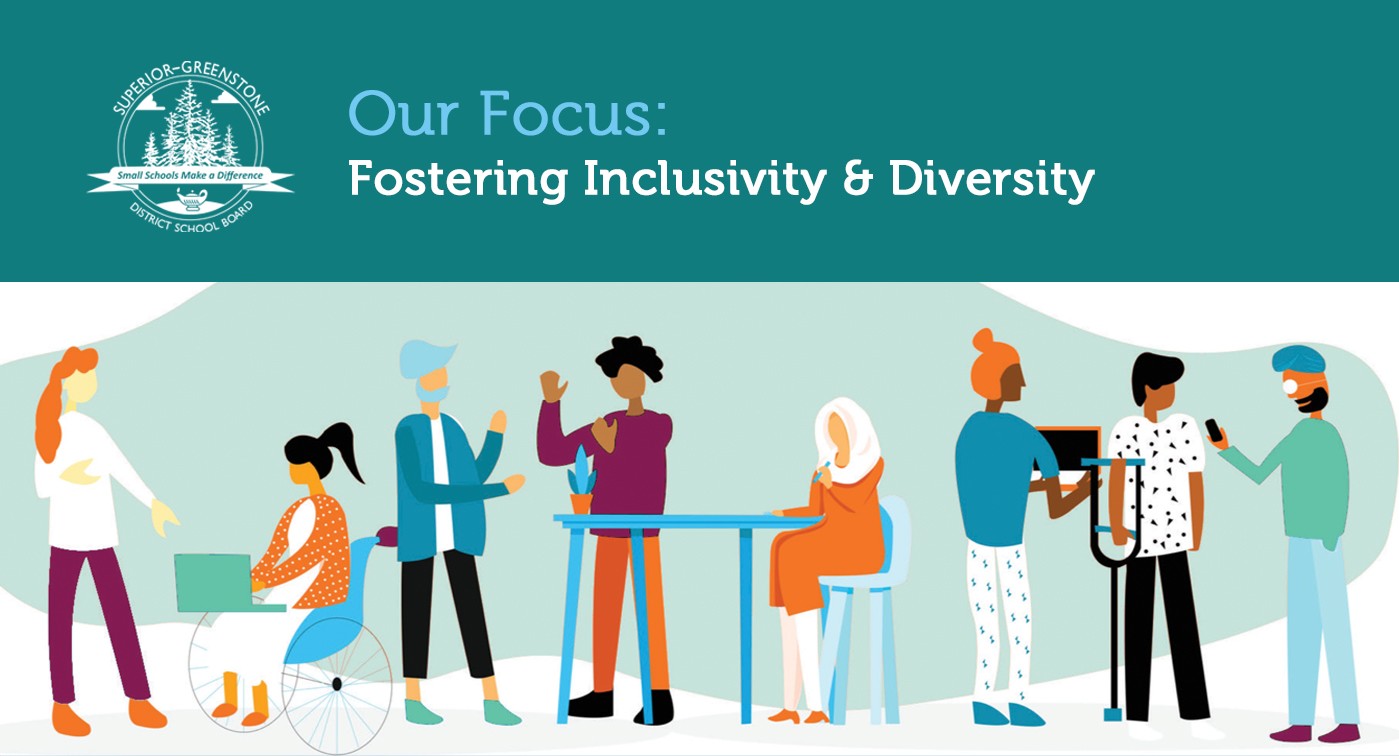Fostering Inclusivity & Diversity
What does inclusion mean to you and your child?
Diversity and Inclusion are words that are often seen together and sometimes even used interchangeably, but they are different!
Diversity looks at all the way people are different in any given space. In our schools, we have diverse representations of race, ethnic background, gender, religion, and ability, to name a few. Inclusion examines how we treat diversity in an environment, and the attempts we make to create spaces where everyone feels welcomed, respected, valued, and supported.
Inclusion is the guiding principle of our education system and the Ontario Human Rights Code. At Superior-Greenstone District School Board (SGDSB), we strive to create and provide learning environments that go beyond physical integration; we want learning environments that continually improve to be responsive to the diversity of our communities.
To support us in this work, we encourage your feedback through our ThoughtExchange platform.
Visit https://tejoin.com/scroll/193504589 and tell us what does an inclusive space at Superior-Greenstone District School Board look like to you?
Q: What is SGDSB doing to foster inclusivity and diversity?
A: SGDSB has committed to further understanding the diversity of our learning community, from our students, families, staff, and community partners. Through data collection efforts, such as the Student & Employee Censuses, we can get a better idea of what our existing diversity looks like. The data on our diversity is crucial for developing inclusion action plans.
We want to create environments where students and families can see themselves represented in the curriculum and school community. Currently, our work to make this happen is grounded in providing Culturally Relevant & Responsive Pedagogy (CRRP) and approaches consistent with Universal Design for Learning (UDL) principles, such as providing multiple means of engagement, representation, and expression.
Q: How does diversity and inclusivity benefit my child?
A: Countless studies have shown consistent results about the benefits of diverse and inclusive learning environments for all children, commonly noting these children demonstrate stronger critical thinking skills, academic success, and intellectual engagement. Additionally, research has also suggested that these learning environments also promote lasting feelings of safety, security, and empathy.
Q: What if I don’t live in a diverse area?
A: We sometimes limit our understanding of diversity to things that we can see; however, by doing so, we don’t appreciate the diversity of our community that cannot be seen at first glance. For instance, two individuals can look very similar but have different ethnicities, abilities, or religions. Even though a community may look homogenous, it is still incredibly diverse.
Q: How is SGDSB advancing inclusion for children, staff, and/or families who are historically or presently marginalized?
A: SGDSB is committed to equity and providing every member of the board the opportunities and tools they require to succeed. While providing diverse representation in the curriculum through CRRP and Universal Design benefits all children, it is particularly beneficial for those who have experienced discrimination. When students see themselves represented positively in learning environments, they report higher levels of academic success and psychological safety. Providing lessons and assessments in a variety of formats allows students to better develop their own self-regulation strategies for learning, better equipping them for future success.
As part of our action plan to move towards reconciliation with First Nation, Métis, and Inuit communities, we endeavor to provide system-wide learning opportunities on decolonization and reconciliation, and to work with local communities on how to best recognize Indigenous Days of Significance.
SGDSB is also continually reviewing policies, practices, and procedures to ensure they do not promote discrimination in any shape or form.
Q: Who can I contact if I believe that the principles of diversity and inclusion are not being met at my child’s school or at the board?
A: Parents are encouraged to first discuss these matters with your child’s teacher, if possible. If you cannot resolve the issue with the teacher, follow up on the matter with the school principal. Should issues persist, please contact your Superintendent of Education, or the board Human Rights & Equity Advisor.

